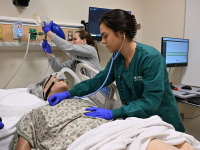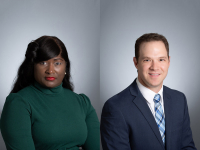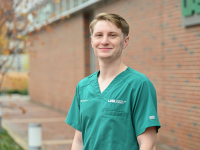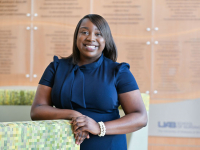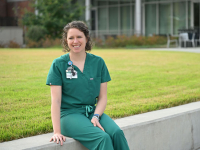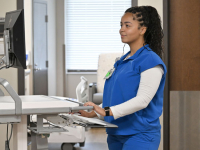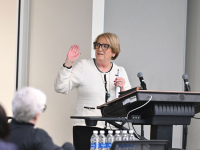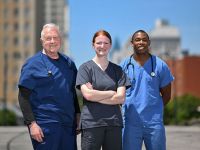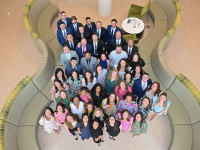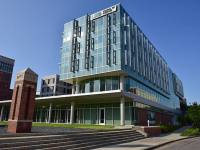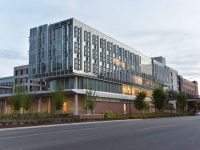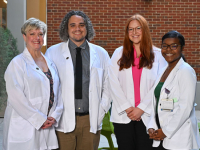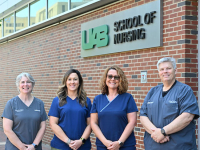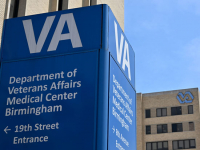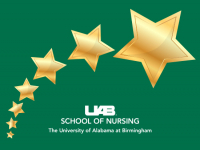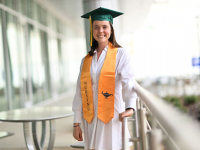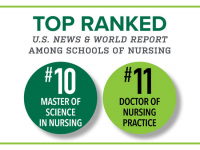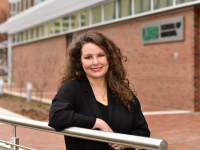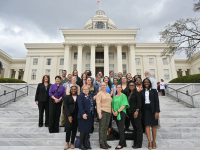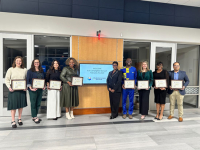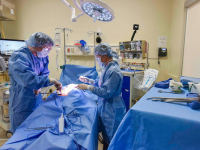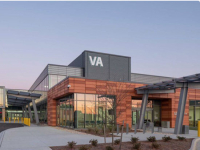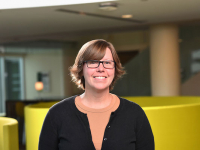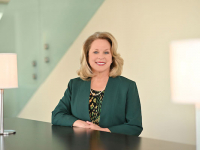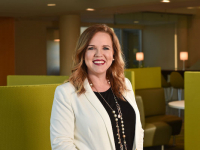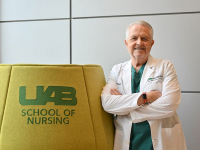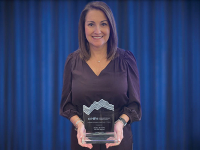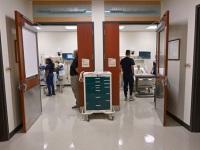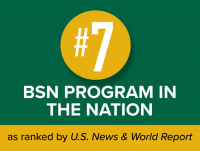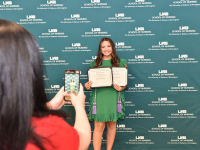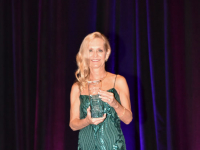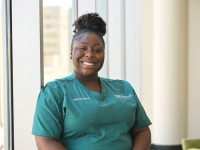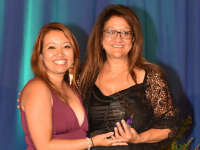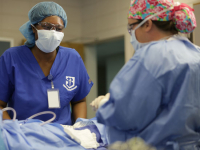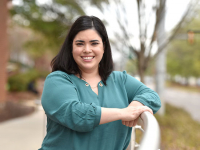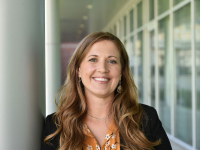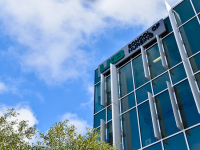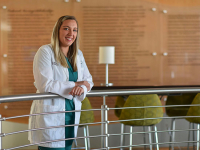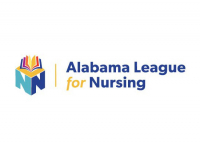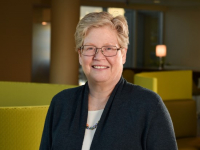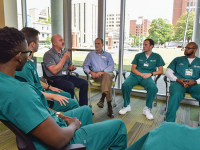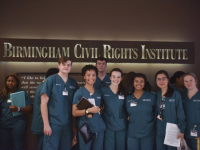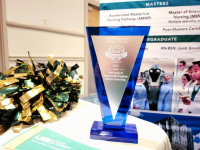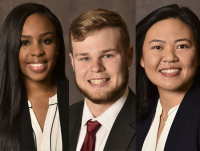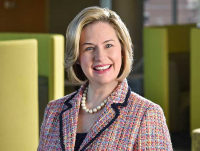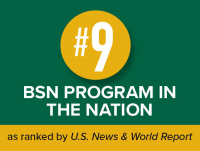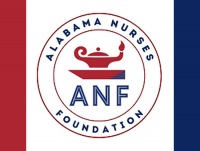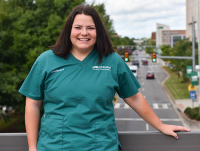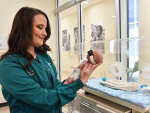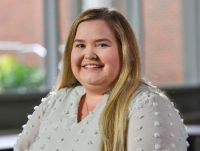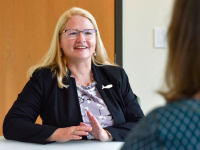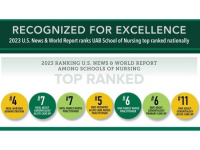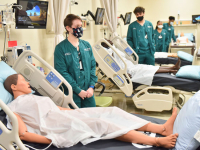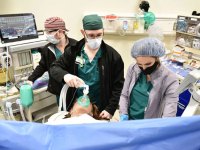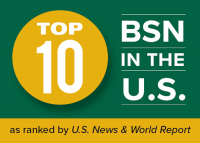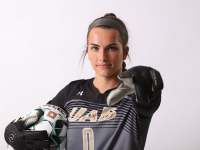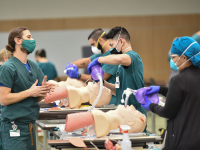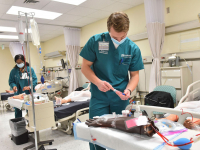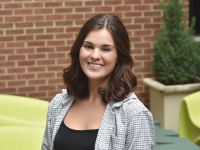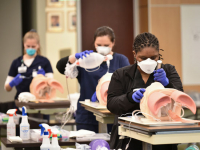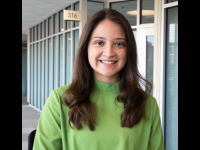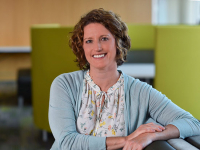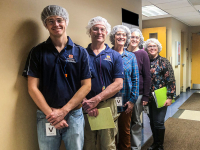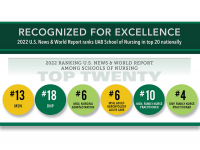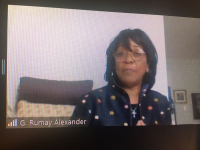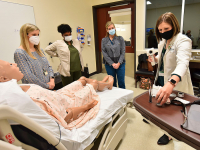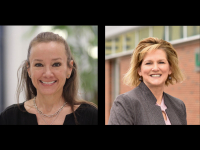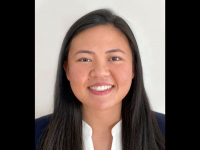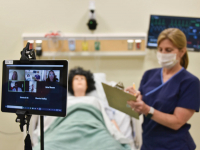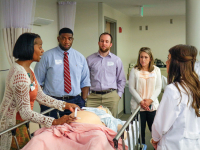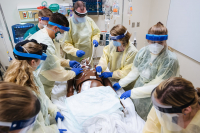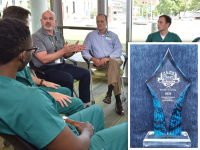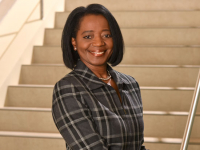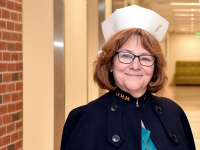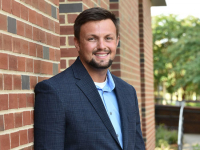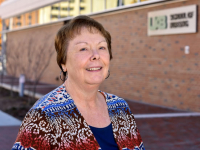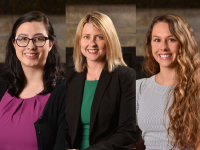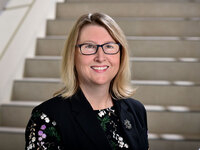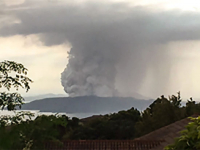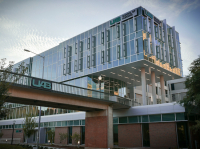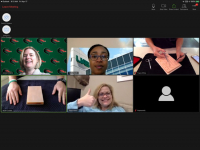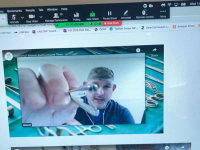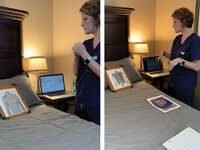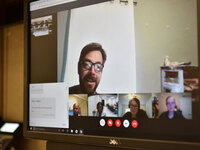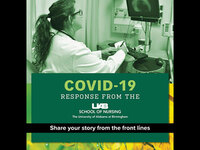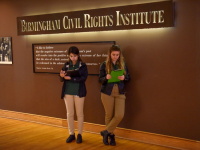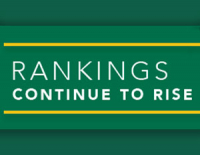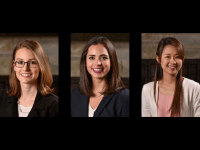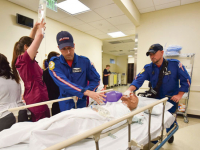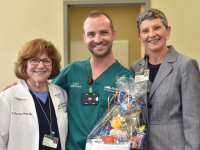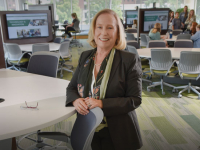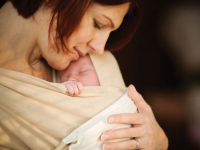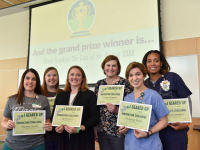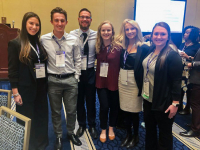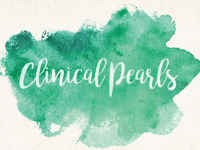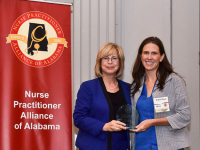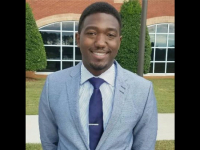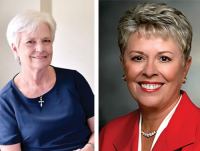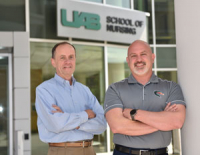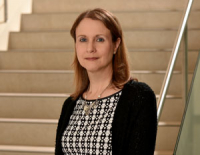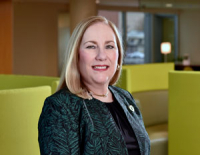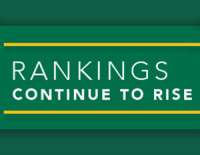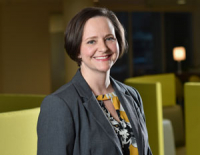 The evolution of technology and its interaction with education and health care opens new opportunities to learn, collaborate and provide care. The UAB School of Nursing continues to pursue its vision of innovative leaders transforming health by utilizing and integrating the tools and technology that promote excellence in nursing education and high-quality care.
The evolution of technology and its interaction with education and health care opens new opportunities to learn, collaborate and provide care. The UAB School of Nursing continues to pursue its vision of innovative leaders transforming health by utilizing and integrating the tools and technology that promote excellence in nursing education and high-quality care.
Through its renowned faculty, innovative programs and new, state-of-the-art building, the UAB School of Nursing continues to lead the way in reimagining nursing education.
The School is nationally recognized for its leading-edge academic programs, which not only are on the cusp of the latest trends in education and technology but also are preparing the next generation of professional nurse leaders who will discover and implement the latest findings in nursing and health care.
For 2020, U.S. News and World Report ranked five UAB SON graduate specialties in the top 10 and one in the top 15, reflecting the quality of all the undergraduate and graduate programs offered at the School.
“These rankings show the sustained impact on nursing and health care of all of our programs and specialties across our education, research and practice missions,” said Dean and Fay B. Ireland Endowed Chair in Nursing Doreen C. Harper, PhD, RN, FAAN. “Consistently receiving top 10 and top 15 rankings among graduate nursing specialties not only illustrates that the UAB School of Nursing provides a high-quality education, but it also shows our dedication to continuous evaluation and improvement of that education and the breadth and depth of faculty expertise. Our faculty continue to develop and refine all of our programs, integrate the latest technologies and provide the most up-to-date clinical knowledge available.”
Since opening its 72,000-square-foot, $32 million building expansion, the School has seen more than 40,000 learners come through its simulation spaces, which include a competency suite with four patient rooms, one operating room and a nurse’s station, a home health suite and a multi-bed simulation room.
“We are fortunate to have access to some of the latest models of lifelike manikins and a simulation space that can actually function as a full-blown complete acute care hospital unit,” Harper said. “These resources allow us to expand the horizons of our students within a safe, low-stakes environment, and our faculty and staff are utilizing those resources to the fullest extent.”
The expanded simulation space not only opened new opportunities for regular class simulations; there also are opportunities for more unique simulations as well. Each year, the Pediatric Acute Care Nurse Practitioner graduate specialty track holds a 20-minute bus crash simulation to provide experience in a mass-injury event. This year, it was held in the new space.
“Our ultimate goal is to provide a realistic experience so students can apply the knowledge, skills and attitudes they have learned,” said Assistant Professor and Pediatric Primary Care NP Tedra Smith, DNP, CRNP, CPNP-PC, CNE (MSN 2004, DNP 2011). “A simulation involving manikins and standardized patients in now what essentially is a small hospital, gives them the opportunity to bring everything together and assume the role of a nurse practitioner in a setting that is similar to what they would encounter in practice.”
 Over the summer, the School also held its first simulation regarding neonatal abstinence syndrome (NAS), a withdrawal syndrome that can occur in newborns exposed to certain substances, including opioids, during pregnancy.
Over the summer, the School also held its first simulation regarding neonatal abstinence syndrome (NAS), a withdrawal syndrome that can occur in newborns exposed to certain substances, including opioids, during pregnancy.
“The diagnosis of NAS has been around for a while, but as the opioid epidemic has grown, we are reevaluating how we approach managing withdrawal symptoms in newborns,” said Assistant Professor and Graduate Core Course Coordinator Curry Bordelon III, DNP, CRNP, CNE, NNP-BC, CPNP-AC (DNP 2016). “In the Neonatal Nurse Practitioner MSN specialty, we have developed a learning module on opioid withdrawal and the effect on infants. Through the simulation, students apply their didactic knowledge and interact with a simulated mother and baby.”
Simulation and innovation are key components to modern education, said Associate Dean for Technology and Innovation Jacqueline Moss, PhD, RN, FAAN. As a new generation of technology savvy students enter nursing school, creative classroom practices keep students engaged and allow an additional level of connection to the content. In the School's new Innovation Collaboratory, faculty utilize document cameras to project topics throughout the room. The setup of the room also allows faculty to implement class-wide collaboration and smaller group work, while integrating video, audio and patient images such as CT scans and X-rays.
“This has allowed us to expand the integration of simulation and experiential learning in the classroom,” Moss said. “By making these a vital part of our curriculum, students remain highly engaged. By integrating technology in the classroom and using innovative teaching methods, such as allowing students to share their computer screens and gain presentation experience in our Collaboratory, we connect with these students and present information in a way that’s relatable to them. As technology enables students to be more engaged and monitor their own mastery of concepts and skills, we are creating lifelong learners.”
Faculty continue to collaborate on new ways to integrate technology and creative practices in the classroom. This includes “Coffee in the Collaboratory,” a monthly meetup where faculty can brainstorm new activities and different ways to utilize the School’s state-of-the-art technology.
“Innovation takes trial and error, and at times it can be intimidating,” said Assistant Professor and Director of Instructional Innovation Nancy Wingo, PhD, MA. “‘Coffee in the Collaboratory’ encourages taking those leaps, sharing successes and supporting each other through the errors. It’s one of the many steps the School has taken to foster a widespread culture of innovation.”
“We also have to prepare students to be ready to use the technology now found throughout all facets of health care — not just in our society,” Moss added. “It touches everything we do in the nursing profession, including electronic health records, telehealth and connecting with patients virtually.”
Fulfilling its strategic priority to expand health care to rural and underserved populations, the School has employed the latest equipment in simulation, including lifelike manikins, high-tech medication carts and telemedicine equipment, for several years and focused on telehealth and its importance in closing gaps in care. Throughout Alabama, a shortage of health care providers limits access to primary and specialty care. Telehealth provides critical care to patients within their homes and it is important for nurses at all levels to be familiar with the technology.
 “Telehealth is the future for how many people will receive their care,” said Smith, who teaches telehealth-centered content at the School. “It is important for our students to be familiar with telehealth equipment and the proper way to deliver care through telehealth because its use will continue to grow.”
“Telehealth is the future for how many people will receive their care,” said Smith, who teaches telehealth-centered content at the School. “It is important for our students to be familiar with telehealth equipment and the proper way to deliver care through telehealth because its use will continue to grow.”
Prelicensure students first become acquainted with telehealth equipment during simulations, in which they examine patients as a faculty member serves as nurse practitioner and observes via web camera. This mimics a scene often found in modern health care, where a registered nurse examines the patient and the imaging is sent virtually to an advanced practice registered nurse or physician specialist in a different location.
Knowing what trends are on the horizon in nursing and health care comes from a connection to practice. The University of Alabama at Birmingham and UAB Hospital, on-campus partners Children’s of Alabama and the Birmingham VA Medical Center, and a variety of community partners provide countless opportunities for collaboration, faculty practice, observation and research that in turn enhance the classroom experience.
The UAB Nursing Partnership with UAB School of Nursing, UAB Medicine and UAB Hospital has been nationally recognized for its efforts. This academic-practice partnership not only provides opportunities for students, but has also improved patient satisfaction rates and clinical outcomes. Across campus, the School of Nursing also collaborates with other schools and departments to encourage interprofessional teams, collaboration and innovative thinking.
In addition to encouraging faculty to continue to grow the number of faculty practices and collaborations with colleagues across all of the its partners, the School is dedicating additional resources to training and evaluating adjunct faculty. The School hosted an adjunct faculty training over the summer, creating a large cadre of potential adjuncts who can share their clinical expertise with students.
“This year has seen a new dedication to preparing our adjunct faculty to enter the classroom,” said Senior Associate Dean for Academic Affairs Linda Moneyham, PhD, RN, FAAN. “Not only has our reputation as a leading educational institution meant that we have the pick of the cream of the crop of educators, but we have also found that providing up-front training to these experts in clinical care prepares them to succeed from day one in the classroom. Adjuncts are a great resource for our school and students, as they bring up to date clinical experience and current knowledge into the classroom.”
As adjuncts bring a knowledge of daily practice and challenges to the classroom, they also open doors to new learning opportunities for students through preceptorships and partnerships.
“There are a lot of practicing nurses with an interest in impacting future generations of nurses through teaching,” Moneyham said. “Supporting and preparing adjunct faculty in this way is the best of both worlds for all involved parties by fortifying the bridge we have between didactic and experiential learning.”
As these experiences prepare students to handle growing areas of need, the School also prepares students at all levels to address health care quality and safety concerns to improve care for patients and families.
Quality and safety are integrated in didactic content from prelicensure to graduate and doctoral levels, and the School continues to impact care through improvement projects at local hospitals, nurse-managed clinics and through research.
“We know there is so much we as a School can impart to the health care professionals in Alabama and the Deep South regarding the importance of being proficient in quality and safety principles,” said Professor and Rachel Z. Booth Endowed Chair in Nursing Pat Patrician, PhD, RN, FAAN. “By educating nursing students, nurse educators and practicing nurses, we take steps toward preparing all nurses with the knowledge and skills to help continuously improve the quality and safety of the health care systems in which they practice.”
The School also is impacting the education of future nurse leaders through a post-MSN to Doctor of Nursing Practice (DNP) Pathway for nurse executives.
“We see nursing and health care leadership needs are becoming more diverse and complex. There’s a broader need, and by focusing on these areas, we’re filling gaps in education and creating leaders who can generate solutions for the most challenging and complex problems that health systems face today,” Moneyham said. “By providing them with quality improvement knowledge, critical thinking skills and advanced leadership skills, we educate nurses who enter the field ready to lead at all levels and collaborate across disciplines to solve health care's most challenging issues.”

